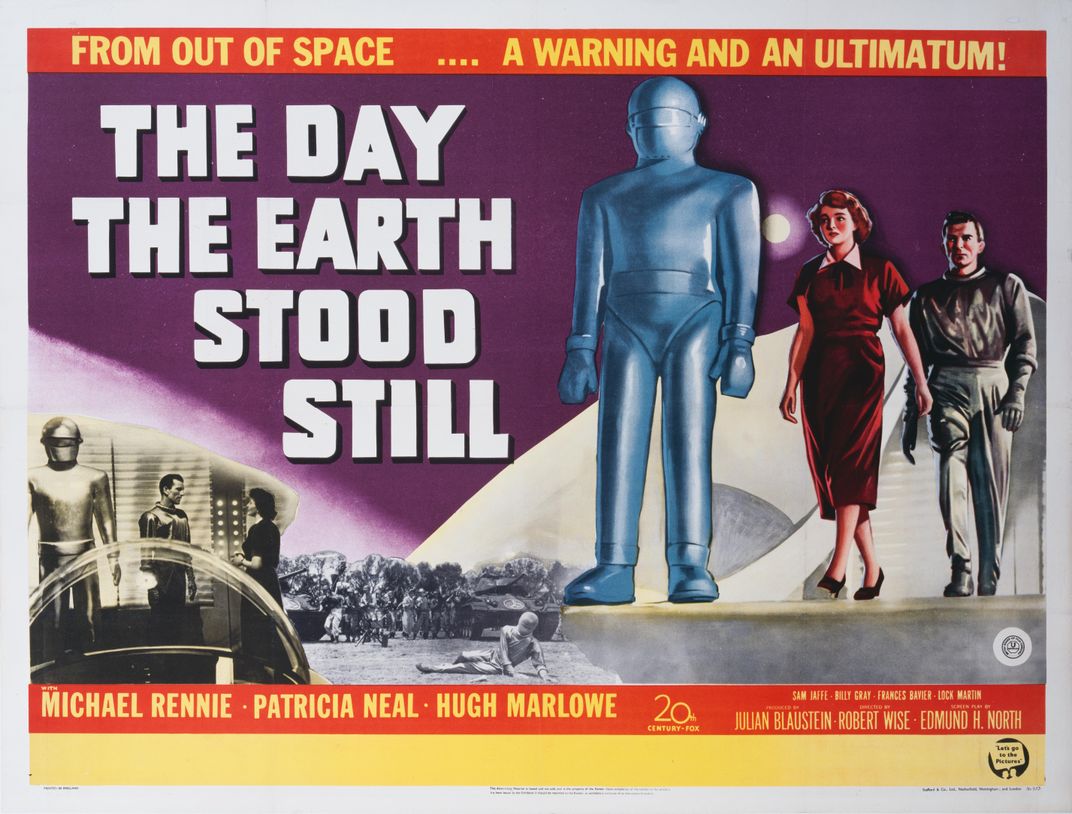Two Monumental Sculptures Welcome Visitors Back to the Hirshhorn Sculpture Garden
Both artworks evoke peace in the time of pandemic
/https://tf-cmsv2-smithsonianmag-media.s3.amazonaws.com/filer/0a/6f/0a6f6bb1-ee98-4676-97ff-116f7c70ceb9/hmsg_tr854_20200722_004.jpg)
In the 1951 sci-fi classic The Day the Earth Stood Still a flying saucer landed in Washington D.C on The Ellipse, not far from the National Mall. Eventually the alien Klaatu emerges from the sleek spaceship to declare “We have come to visit you in peace.”
We Come in Peace is also the title of the Huma Bhabha’s monumental,13-foot, 3,300-pound sculpture that now stands not far from the fictional UFO landing spot within sight of the National Mall. Looking more like the mysterious giant robot that also emerged from the spacecraft, it’s one of two mammoth works that will be unveiled when the sunken Hirshhorn Museum Sculpture Garden reopened today for the first time in five months.
Aliens in that influential 20th century science movie may have stopped the world for 30 minutes, but in real life 21st century drama, a worldwide coronavirus pandemic has caused a far longer interruption.
Since March, all of the Smithsonian museums, galleries and properties have been shuttered. Only recently have they begun slowly reopening with social distancing and mask requirements. On July 24, the National Zoo and Udvar-Hazy Center of the National Air and Space Museum in Chantilly, Virginia, both opened with restrictions.

The Hirshhorn sculpture garden, along with the Enid A. Haupt Garden, and other nearby Smithsonian gardens will be the latest to reopen during the crisis. It will be the second sculpture garden in Washington D.C. to do so, after the National Gallery of Art sculpture garden reopened with limited hours and restrictions on June 20. The Hirshhorn building and the outdoor plaza beneath it will remain closed, as will the other Smithsonian museums along the Mall for now.
“We are proceeding cautiously, and we will pause when necessary,” Smithsonian Secretary Lonnie Bunch told employees in a memo. But for now, he said, “our outdoor gardens allow for social distancing, optimal circulation paths, and strong crowd management.”
The down time allowed the museum to revamp the sculpture garden, which attracts 100,000 visitors a year. Using a plan from artist and architect Hiroshi Sugimoto, it repaired infrastructure and added accessibility to the 1.5-acre garden, where more than 30 modern and contemporary works are displayed from Auguste Rodin to Jean Arp and Henry Moore.
“We are thrilled to welcome visitors back into our sculpture garden, a safe summer respire,” Hirshhorn director Melissa Chiu says. “Our mission is to open the museum up to share the art of our time with as many people as possible. The reopening of our garden is one step closer to this ongoing objective, culminating in the garden’s redesign.”

The two newest and largest sculptures in the garden will harken the reopening and redesign. Besides Bhabha’s imposing Peace, a bronze meant to reflect its original materials of cork and styrofoam, there is the twice as tall, 24-foot Double Candle from Los Angeles-based artist Sterling Ruby. The king-sized tapers are reflected on a pool in front of it, evoking its own kind of peace that the Bhabha’s menacing standing figure with its scowls and multiple faces do not.
A variation with the same title Double Candle was part of a Ruby survey at Boston’s Institute of Contemporary Art earlier this year, albeit covered in American flags. Similarly, the Hirshhorn sculpture, dated from 2018, has uneven surfaces cast in bronze—with each individual candle weighing about 3,600 pounds.
According to a museum release, “the candles will stand as recognizable beacons: twinned totems with a resolute yet melancholic presence that calls to national memory and unity.”
Bhabha, a Pakistani-born artist who works in a studio in Poughkeepsie, New York, created her work for a celebrated rooftop exhibition at New York City’s Metropolitan Museum of Art in 2018.
“I’ve always been interested in the idea of giants walking the earth,” she said when it was unveiled there. “The fact they look monstrous and kind of scary is kind of like special effects.”
By using cork and Styrofoam to create the original figure, she could easily slash into their surfaces for marks that were reproduced in the final bronze. The red blue and black paint on its torso and face bring to mind the urgent jets of spray paint that have appeared on some of the city’s other monuments amidst a summer of protest and a national reckoning over racial justice.
“Each artwork carries significant political resonance and encourages visitors to engage with timely issues through art,” Chiu says.
Visitors will be required to adhere to guidance measures from the Centers for Disease Control and Prevention. Masks must be worn by those over six (with face coverings strongly recommended for those age 2 to 6, the CDC advises).
The sculpture garden will be monitored to allow safe capacity; some may have to wait if it reaches maximum capacity. Social distancing of six feet will be asked, and there will be some one-way paths. There will be some hand sanitizing stations around as well. But no spaceships.
The sculpture garden of the Hirshhorn Museum in Washington, D.C. will be open 10 a.m. to 4:30 p.m. daily. The museum will remain closed.
/https://tf-cmsv2-smithsonianmag-media.s3.amazonaws.com/accounts/headshot/RogerCatlin_thumbnail.png)
/https://tf-cmsv2-smithsonianmag-media.s3.amazonaws.com/accounts/headshot/RogerCatlin_thumbnail.png)